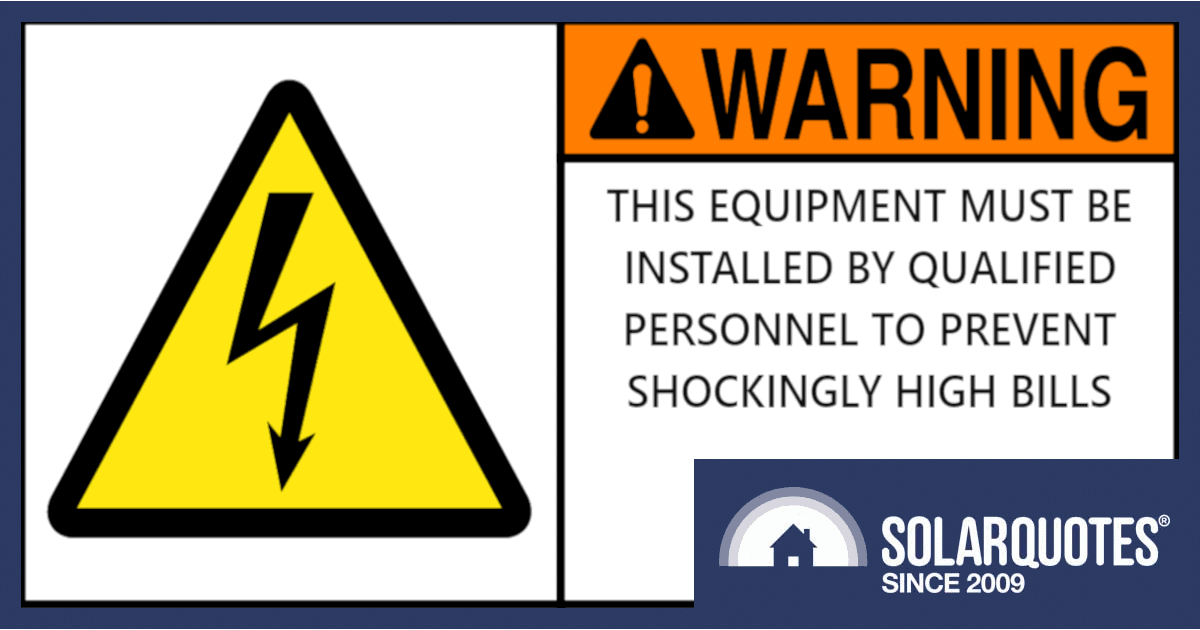
Be careful when engaging non-battery-savvy electricians to work on your battery-powered home…
There was so much red ink, it looked like a murder scene.
Not long ago, in a suburb not too far away from SolarQuotes HQ, a solar/battery system owner made contact. He was engaged in an age-old battle, arguing with his electricity retailer about what seemed to be excessive charges on his power bill.
Luckily this person was within range of Irene the i-Miev, so SolarQuotes dispatched an intrepid investigator. 13 km / 2.1 kWh / 80 cents later, I arrived to interrogate the embattled consumer Kevin and his solar/battery system.
Kevin had invested in solar panels before moving into the house and then spent more on a Tesla Powerwall. His quarterly bill disagreed with the numbers produced by the Tesla monitoring, and Kevin was flummoxed.
What Are The Elements, Dear Wattson?
Looking inside the switchboard we found lots of gear, including a stand-alone Clipsal monitoring device. This is the same hardware sold by Solar Analytics, and manufactured for Watt Watchers.
At first blush, nothing appeared to be out of place with either the main switchboard or the Tesla gateway.
Progressing inside, I could see the confusion. The Tesla app was showing a charged battery and good solar energy yield. The Clipsal energy app wasn’t as intuitive, but both seemed to agree there wasn’t much electricity being imported from the grid.
The retailer begged to differ. Not only did they have bills issued for energy consumed, but they also forwarded the raw data the bills were based on. Not everyone realises that as an account holder you can contact your DNSP and get the interval data, which breaks down your consumption into 15-minute blocks and conveniently presents it in a column graph.
So Kevin showed me the interval data on his desktop PC. Indeed, there were some big slabs of consumption. We concentrated on mid-winter with the most electricity imports and the least solar generation. He explained the repetitive square-edged blocks of energy use began at midnight and finished at 6 am because there was a heat bank programmed to these times. Regular as clockwork. Interesting.
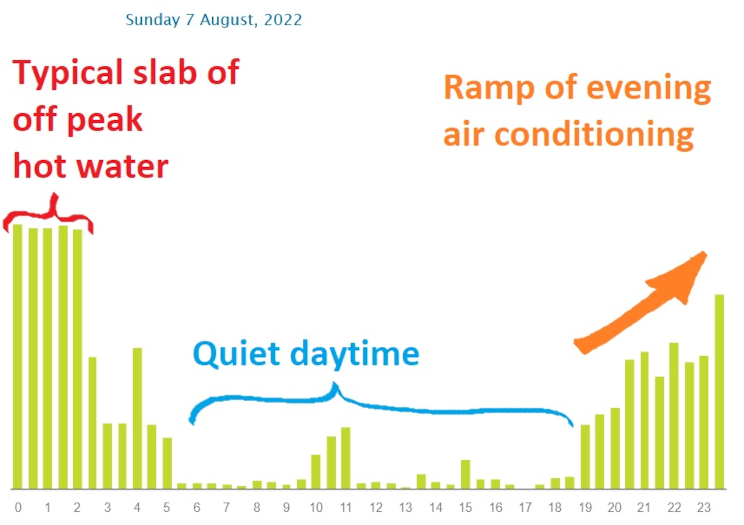
How to interpret some interval data. Solar consumption monitoring can produce more or less detailed versions of this information.
The penny soon dropped for two reasons:
- First, if the Tesla battery had been powering this hefty load there would be some ramping or, depending on state-of-charge, variation as to when the grid consumption started each night.
- Second, the Tesla app showed 80% charge at sun up most mornings when the battery should be flat around 4 am.
You’ve Never Heard Of A Heat Bank?
Heat banks are a box of bricks heated by a toaster element. According to the label, this particular one has almost 150 kg of thermal mass, which will use ~2.8 kW or ~17 kWh over 6 hours. That is about 130% of the Tesla battery’s capacity.
Typically these heaters are heated up overnight on an off-peak tariff. Convection of air through the wall-mounted appliance heats the room quietly as the ceramic blocks cool through the day. It’s actually an energy storage technology, not unlike your hot water service. A thermal battery well suited to being “charged up” using solar electricity.
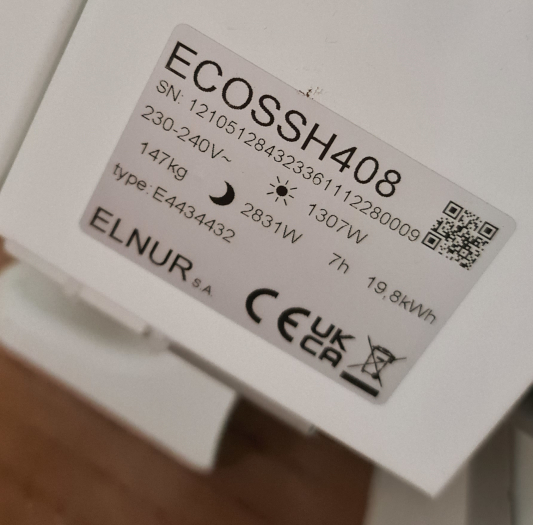
There it is, quietly chomping through as much as 119 kWh every week.
The final piece of evidence Kevin let slip was this heat bank was the most recent equipment installed. So we returned to the switchboard to positively identify the little monster that was quietly chewing up lots of electricity. Whoever installed it failed to label the escutcheon, so it didn’t raise any eyebrows on the first inspection.
Knowing what we were looking for meant it was much easier to identify the circuit breaker and, more importantly, the wire supplying it sneaking away from the main switch. This connection was upstream of the Tesla gateway, which meant the battery couldn’t supply the load, and the monitoring system couldn’t see it either.
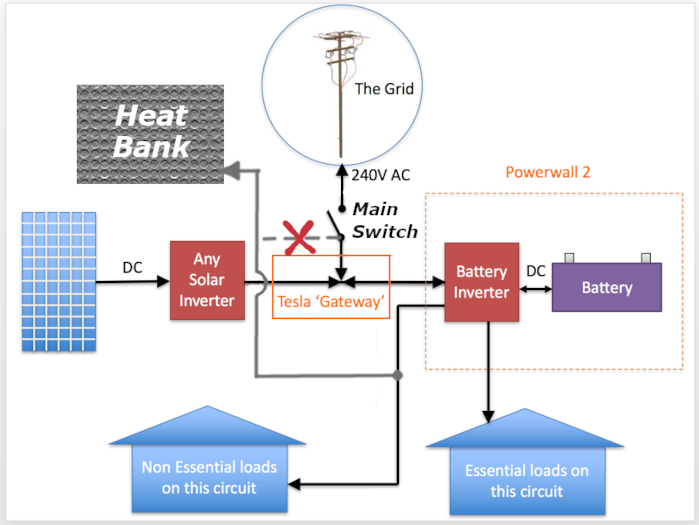
X marks the spot. Removing this connection from the main switch and putting it in its proper place makes all the difference.
So, unhappily for Kevin, his energy retailer was correct. He was using lots of grid electricity overnight. The Tesla battery had done what was expected, supplying overnight loads… the ones it was connected to.
The heat bank installer didn’t know where to pick up the supply in the switchboard, and the customer wasn’t aware of it either. It is a simple mistake to make if you’re not inquisitive enough to ask.
Just to be clear, it wasn’t the solar experts from DQ electrical who made this error. Their Powerwall install and Sungrow solar inverters were excellent. It’s actually great seeing top-notch work like this, with nice service loops and neat conduit work, because they’ve set a precedent others have to follow. There’s nothing more irksome than seeing a nice house disfigured with hack work.
I rectified the situation by putting the heat bank downstream of the Tesla gateway to be monitored along with the rest of the house. It will be interesting to see how the whole arrangement performs across the coming months and the coming winter.
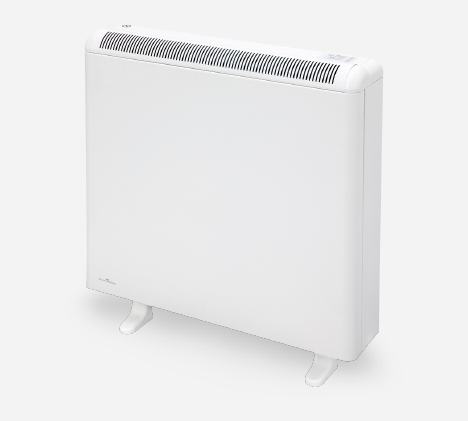
A heat bank looks deceptively simple because it is. 150 kg of masonry takes a while to cool once warmed up.
What Have We Learnt?
- Be careful when adding hard-wired appliances to a solar/battery-powered home. Not all electricians understand or even care about integrating with your solar power system and batteries. Switchboard labelling is essential.
- The whole point of a heat bank is that it stores energy. Using stored electricity in a battery to power another energy storage device is sub-optimal, to say the least.
- The heat bank should either be powered by off-peak electricity or solar. A solar energy diverter automatically puts surplus solar into the heat bank after the battery is charged. In fact, that’s how the heat bank manufacturer is positioning them.
- Heating the house overnight using a home battery would be 3-5 times more efficient with a heat pump. The customer may prefer the silence of a heating element or the comfort afforded by a convection heater, and that’s an economic decision for them.

 RSS - Posts
RSS - Posts



Assuming this all occured in South Australia, I’d be interested to here more about where one could acquire an ELNUR heat bank in Australia?
thanks
mark
@Mark
There is a supplier in Sydney called Heatpac (I suspect this is the Australian branded version of ELNUR).
https://heatpac.com.au/
Dimplex Australia used to sell them, not sure if they still do but I suspect they are also rebranded as Derby Heatbanks. I’ve got their Quantum Heatbank.
http://www.derbyproducts.com.au/ (also located in the outer south western region of Sydney). I would suspect that’s because it’s close to the Southern Highlands where it can get a bit chillly.
And there’s also , for Taswegians ….
https://www.heffernansheating.com.au/contact.html
thanks so much!
Similar set up for me… I have a heat bank but it’s part of the whole house backup by the Tesla Powerwall. I don’t have Controlled Load tariff and use off-peak rate to charge the heat bank (or use solar during the day or both).
Now, people will have a meltdown saying that heat banks are the least efficient form of heating (but they are still 100% efficient electrically), there is a nice feature to heatbanks – they provide nice radiant heat that air cons can’t do, especially on a very cold morning (the air con will most likely go into defrost mode and there’s no heat coming out of the air con).
Secondly, in a power outage, the heat bank has stored heat which is very handy to have.
What I do is charge the heat bank during the day from solar as well as charging the Tesla Powerwall (now this can come from both solar and grid as some winter days there is not enough solar PV being generated). Grid is off peak til 4pm. As long as I have the heatbank and the Powerwall charged by 4pm. I will have the peak period covered (4pm-8pm M-F) and the air con doesn’t have to run as hard as the heat bank slowly releases its stored heat and the Powerwall can easily handle the 4hr peak period to run other things. My Powerwall will mostly charge from the gird during the winter period.
But, it is a case of “caveat emptor”, customers need to confirm the load connections arrangement when adding a Powerwall and when adding new loads to see how power flows are being utilised before leaving it too late when things get out of hand or unprepared for. Unlike the couple in Victoria who made the mistake of finding out their Powerwall was completely discharged during a storm when they forgot to turn off their floor heating system and find they didn’t have any battery energy to provide power to the essential loads like lighting/fridge/etc. In that case, they should have a done a test run by taking the Powerwall “off grid” and turn on appliances to see what happens.
In the early 70’s we had a heat bank appliance in the store “office” in Canberra. In winter as you say the radiant heat was very nice -often drawing staff away form wherever to enjoy the de-chilling experience. That was about the best you could say for it (as installed).
I think you clinched it with point 4.
I went through a similar thought process, what can I do with my excess solar – heat bank sounds ideal somewhere simple to dump energy into during the day which then gets slowly released to cover those cold nights. Then I did the calculations and for the same heating effect the financial cost/ returns are better for an electric battery and heatpump, not to mention you can use the electric battery to power other things as well.
@Mark
No doubt about the financial benefit for home battery and heat pump.
However, some people detest using air cons (RCAC) as they simply don’t like the blowing hot air (for some, this may be for health reasons such as dry eyes and RCAC have a dehumidifying effect, so a double whammy, hot dry air blowing and the skin dries out). Since air cons blow air around which means more dust/allergens/pathogens are stirred up and circulating in the air then people with allergies or respiratory problems will find radiant heat is much kinder for these reasons. So, it all depends, it may not just be a financial incentive to use heat pumps for some people as other non-financial benefits needs to be considered.
For me, the heatbank and the RCAC combined, achieves the best of both worlds as a compromise. The combined efficiency of the two systems is about 210% of energy input relative to heat output. Pure RCAC will achieve about 330% of energy input. So, it’s a compromise I can live with, I get 210% efficiency and have the benefit of both radiant and blowing air heat. That is, for 32kWh input, I can get 68kWh of heat output. 16kWh for heatbank at 100% = 16kWh out. 16kWh input for RCAC nets about 52kWh, so total heat out = 68kWh for 32kWh in (210%). Pure RCAC mode for 68kWh, will require about 21kWh input, about 11kWh less than a combined system. Most people when they come to my house will gravitate to the heatbank as some sort of primal instinct seems to attract them to the radiant heating effect. Use of solar PV helps.
However, I do question the run time of heat pumps continuously, the compressor keeps working meaning wear & tear and eventually the gas will need recharging or the unit needing replacing.
A heatbank is fairly simple in terms of tech as there’s no gas or moving parts (except for a small fan for forced heat discharge). Installation is much cheaper compared to a RCAC.
However, the heatbank can’t do cooling in summer which is a deal breaker for some. Or not.
A comment on the psychology of human comfort. The sensation of comfort is determined by a few factors. Among them the radiated heat reaching our skin. So when we receive radiant heat from warm walls, fireplaces and heat banks in a 23 degree air temperature room, we feel much more comfortable than in another 23 degree warm air temperature room with frosty walls and cold window panes. We simply emit lots of our own energy via radiation, and feel uncomfortably cold while the thermometer for air temp shows the same temperature.
@Mark
Just one problem with RCAC/Heatpumps… it can only heat air (as far as space heating is concerned). Air has very low mass and a low heat index, thus can not store heat for long and is quickly lost, so it needs constant heating. Hence, why it needs a lot of energy to feel warm in a heated air space and just as well heat pumps cover that due to their efficiency. Psychologically, it feels warmer but energy wise, air takes a lot of energy to heat and maintain. The heat in in the room is lost very quickly once the RCAC is turned off as only the air is heated, no objects in the room were able to absorb the heat produced by the RCAC/heatpump. Heat transfer from air to object is not very efficient by conduction. Heatpumps are more ideally suited to hot water systems (where you can store the heat longer and efficiently as water has a very high heat index compared to air).
Radiant heat = heat energy is absorbed by objects. So the heat from the heatbank is not only released to the air (via convection) but also radiates (in my case), to the tiles and nearby walls/furniture. The tiles, wall, furniture then radiate that heat outwards. Uses thermal mass as its advantage using radiated heat. Psychologically, we don’t feel this effect as much as space
heating does. But energy wise, radiant heat is more effective. The heat is still radiating long after the power source has been removed since the heat has been stored in medium that has a higher heat index than air.
I was wondering if anyone produces heat bank, but uses a hot water heat pump to charge it. Seems like the best of both worlds – higher efficiency charging and dense storage.
Heat Banks definitely have their place in storing solar generated electricity. However, being 100% efficient is not as good as it sounds when Heat Pumps are 300% to 400% efficient.
Anthony, You may have found a new vocation chasing missing kWhs for the readership! We had an issue with our supplier in Perth and after much fruitless complaining over months (we have an Enphase system connected to a Tesla battery so had two consumption and export readouts which were both the same) but all to no avail their meter was correct.
To my huge amusement they replaced the meter with a new flash one with interval readouts a few months ago and I asked the tech doing the work if the old meter was working correctly? He said he did not know but indicated that it could be tested.
All quiet for a couple of months and then a Christmas surprise we noticed a nice credit on our account. No apology or admissions but hey you cannot get everything in this life.
With the off-grid feature on the Tesla system we can disconnect from the grid for a week or two in summer as long as it is not too hot and of course we have to forgo any exports during this period. The interval readings showed zero during our test.
We can now see agreement with the new meter and the households’ systems for consumption. Nowhere for them to hide now but the supplier setup makes resolving an issue very difficult with Synergy as a retailer and Western Power as the party responsible for the metering and physical connections.
Why not power the heat bank via solar in the day time?
Customer should have spare 17kwh of export to use.
Everyone is on the same page with you there Andrew, have a look down the bottom at point 3, there’s a hyperlink to the heat bank manufacturer. Cheers
Hi Anthony, thanks for a great detective story. It reminded me of my own home situation, where I used to charge my PHEV car off an outlet (2.2kW draw) inside the meter box on the boundary of the property. When my solar battery system was installed, luckily my installer reminded me that the meter box outlet was not part of the battery backup system. So now I charge my car with a heavy duty caravan extension cord off an dedicated external outlet at night, This works fine until I buy a proper EV, when I will need to buy a dedicated charging outlet and remind the installer to install it on the battery backup circuit.
Robert,
I am not in favour of charging the car from your battery. The issue is you get 2 lots of losses. (Charge the battery, then discharge the battery into the EV.)
If the EV is hooked to the grid side of the battery, you will have all the battery available for use in the house (such as saving peak energy, or for backup if it is a backup system.
In my case I have 12Kw of battery installed. This covers the peak usage (17:00>20:00+). If I put that energy into my EVs, I would be paying for peak power.
EV charging is often not thought about: I will not charge at less than abt 10A due to the drop off in efficiency at low current. I try to charge off PV, but if not possible, I use the low rate after 10PM. (Still heaps cheaper than buying Dinosaur Juice!)
What people need to remember is that PV export can be used by the EV (or Hot Water, Heatbank etc) by connecting to the Grid side of any storage. It does need management (in my case manual atm, but I am in the process of setting up Home Assistant to automate energy management in the future.
(Home Assistant is an Open Source home management system that runs on a Raspberry Pi, or something like an Intel NUC. Incredibly powerful! HA is one of the fastest growing projects on GitHub.)
Nice sleuthing Anthony. You’ll be happy to know that with the benefit of the recently released Consumer Data Rights access to the electricity meter data, Solar Analytics will soon be able to automatically detect these discrepancies and inform the owner.
Great idea! That will be epic.
Stefan Jarnason you’re going to make some powerful enemies, pun intended. Retailers rely on oppressively confusing, opaque as possible deals with a dash of imaginary discount when they formulate tariff structures. Click here to totally simplify your power bill. That is going to upend the b#llsh!t as usual business model. What a winner.
I hope you completed a certificate of electrical compliance and gave one to the client (required even if you were not paid)….
It’s in the mail.
On a recent trip to Germany I visited Heidelberg Castle. They had a 200 year old heat bank 3 metres high made of bricks covered with decorative tiles. A fire box at the base supplies heat and by all accounts is very efficient. Some houses still have them.
If you have a rummage through the off grid parts of the internet Richard you’ll find very similar things under the name of “rocket stove thermal mass heater”
Cheers
…Not to mention the Romans did a similar thing!
Thanks Anthony,
An excellent article. Greet sleuthing. What a learning experience for me!
To be fair to our service provider, close monitoring of their metering and charging is possible, once you know where to look. There are clearly traps for consumers and installers when putting in heat-banks or EV chargers or any heavy user of electricity.
Graeme
aka “Kevin”
I had a similar situation when my solar panels were installed.
With a 5kw export limit, I found that when the sun was shining enough
to produce considerably more than 5kw, and there was a load in the house,
this reduced the amount being sent to the grid (rather than increasing
the amount generated so as to keep the amount exported at 5kw).
I only discovered this by looking at the graphs available on the
inverter manufacturer (Goodwe) website. I’d be happy to provide examples
if you give an email address or other way of doing so.
The installer was quick to investigate this and apparently contacted
Goodwe; he said something about a setting in the inverter. But it is
as though the power limiting device was put on the cable from the panels
to the house rather than on the connection from the meter box to the grid.
I would fear that some customers would not pick up such a problem.
I am 100% certain that many customers wouldn’t pick up on the problem.
I have a neighbour who had a new solar system installed a few years ago, and it was literally left switched OFF for the first three months. They wondered why their bill didn’t reduce!
My take from this article is that the heat bank was not connected in the best way for the owner. It was a legal connection it appears. I have had 5 solar systems installed or myself or my children and I have NOT seen a circuit diagram for any of those installations. I am therefore not surprised the electrician that installed the heat bank did it the way it was. It would seem this article has isolated a problem in the way solar systems are installed. I believe a circuit diagram should be provided so the solar installer can do it correctly and other “non-solar” electricians can understand what has been connected. A job for the good folk at Standards Australia for inclusion into the appropriate standards.
Adelaide is in Nathers Zone 16, which on the new Nathers Zone values (better than 6 Stars) allows 46MJ/sqm.yr for heating. A 250 sq m house using 90% of energy for 180 days of winter would be about 17kwh per day. Nathers might calculate this slightly differently. But anyway heat bank as above would be close to normal winter heating load for well insulated house. Running this direct from solar PV during day in winter not very difficult – may need to add a few panels and a diverter. I am in much colder highlands of NSW. Same house 250sqm needs 80kwh per day for 180+ days of heating. What would be most economical setup. (I already have 6.6kw solar, on grid, which for all electric house would be break even for normal house loads over year, but in winter a 2kw heat pump hydronic, going 20 hrs/day at COP of perhaps 2, efficiency and line losses, is about 80kwh costs a bit. Also 100 yr old house is not 6 Star, so supplement with wood fire – country town 7 acres lots of gum trees not a problem. Much of Victoria for example, with higher heating loads needs more information to get off gas heating. Can you do an article on this.
Graham, the attached papers may be of interest for your situation. They set out two different but integrated approaches to try to achieve a self-sufficient air heating system for a freestanding residence.
Small scale interseasonal heat storage does not work due to thermal leakage issues as the volume to surface area of the storage vessel is unfavorable. It can however work well at large scales for instance Drakes Landing in Canada.
Individual home heating seems likely to be best achieved by a modest energy storage maybe using hot water or PCMs and the clever integration of several energy collection methods to smooth out the cloudy days.
I have been in touch with the owner of the Peveril Solar House. He still lives there and the system is still functioning well so it can at least be relied on as a proven approach.
Hi Ian
I’m afraid the links you provided don’t work.
Reverse cycle does the trick for me in Victoria, considered heat bank but realised too power hungry.
@chris
That depends. Reverse cycle ACs are also power hungry appliances. A 7.2kW heating capacity RCAC can draw about 2.4kW on a cold day. Wouldn’t take long for it to flatten a Tesla Powerwall battery (about 5 hrs).
Energy and power are not interchangeable terms.
Heatbanks are 100% efficient but cost-efficiency is won by heat pumps (where they can be up to 600% under the right conditions but to get 600% efficiency also means a smaller RCAC – about a 2kW heating capacity unit which means it only draws about 300Watts under the right conditions).
As soon as you increase the RCAC heating/cooling capacity, their efficiency drops.
A Heatbank on off-peak electricity of 14c/kWh can be just cost efficient as a RCAC running on peak energy at 42c/kWh at 300% efficiency. A heatbank running on excess solar energy is even better because you can store your heat for later use.
Heatbanks can store heat energy for later use, RCACs can not. So they both have their advantages/disadvantages.
Ron, Sorry the links are off some Academic papers I have read and accumulated. I can email copies of the papers compressed into pdfs if you can provide an address as you already have my email address?
If you can find links to them online and post them here, that would be best. But if you want to send them to me my email is:
ronald@solarquotes.com.au
Storing hot water for a hydronics system.
Useful temperature range 50degC to 90deg C (tank with vent at 1 atmos pressure) deltaT=40
Heat transfer coil in tank at Mains water pressure.
Nominal 3 days storage to balance solar gain and usage to about 90%.
One tonne = 1000 litres of water x 40 deltaT is 47 kwh
A nominal 6cub metre tank would store 280 kwh ~90kwh/day
With R5 insulation (to achieve this might be R10 on top, R7.5 to sides and R5 at base)
losses about 3% per day. May be optimistic.
I know my Quantum heat pump loses about 10% per day from the tank in cold weather.
Momentum Energy’s billing doesn’t handle daylight savings. I monitor my solar on a per minute basis and can show that when I turn on a bunch of appliances it turns up one hour earlier in their bills. It even stuffs up and claims my usage goes down to zero at 6am (due to my solar kicking in at 7am), even though the sun hasn’t even risen. I alerted them and after a year they had done nothing to fix it. So this leads to an extra hour of “peak” charges on a TOU plan when the sun is down.
Some very interesting information here. Thank you all.
I live in Bathurst where it can get rather chilly during the winter months.
I have a 6kW solar system installed on the rooftop of my slightly elderly house (1952 vintage), ceiling insulation, double glazed windows and electric panel heaters for warmth.
I can’t afford a lithium battery and as I would only use one to run the heaters during the mains electricity peak times (7 to 9 am and 5 to 8 pm, M to F) I don’t see the point when electric storage heaters (heat banks) are available as a battery substitute at a fraction of the cost.
Trouble is there aren’t many around. Only two makes that I have been able to source on the Net and no dealers close to where I live.
1. Elnur Gabarron’s Ecombi Solar range that encourages charging by excess solar power, with off peak mains back up – also sold as Heatpac brand, but the same one. Manufactured in Madrid with a huge array of electronic bells and whistles that connect to WiFi etc etc
2. Technotherm (German manufacture) sold in Australia as Derby Heatbanks – also suited to solar connectivity for power, but without the fancy controls – just “manual control”
There may be others but I haven’t found them – not a Dimplex currently it seems.
I would like to know from any one out there who has one of these heat banks. How long have you had it? Are you happy with it? Was it easy to install? Have you had any major problems apart from poor Kevin’s saga? Does it live up to your expectations? Would you recommend one to family and friends? Would you install more in your house? Are there any other brands or dealers that I may have missed. How long did it take from making the order to delivery and installation?
Currently I turn all my heaters off during peak electricity charging times and wrap up in blankets. I don’t want to have to do that any more. I don’t want a RCAC. I want to feel warm.
I look forward to your insights.
Diane, call Derby as i think they have a larger unit equipped with a fan and thermostat it is about 32kWh capacity as i recall.